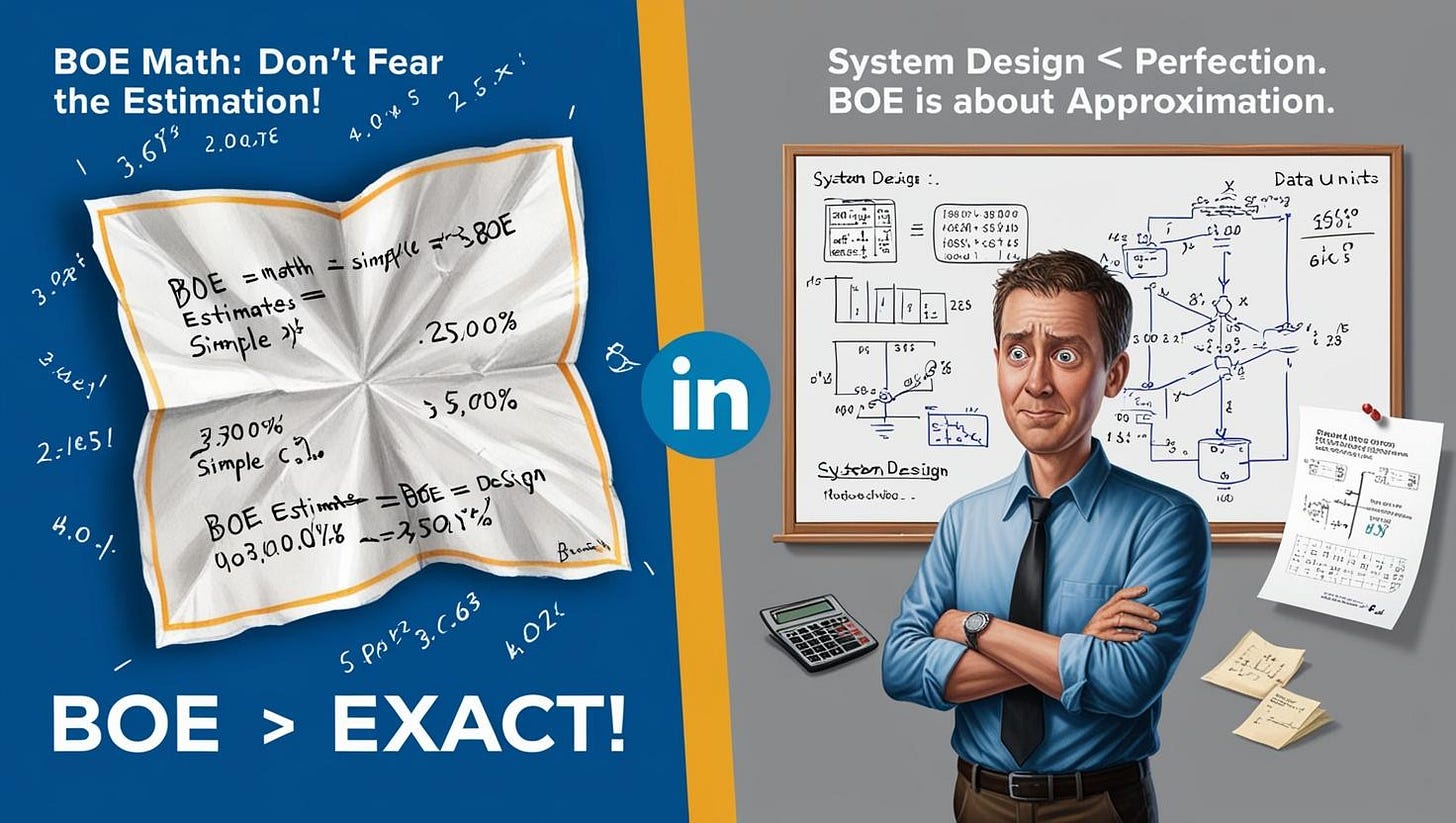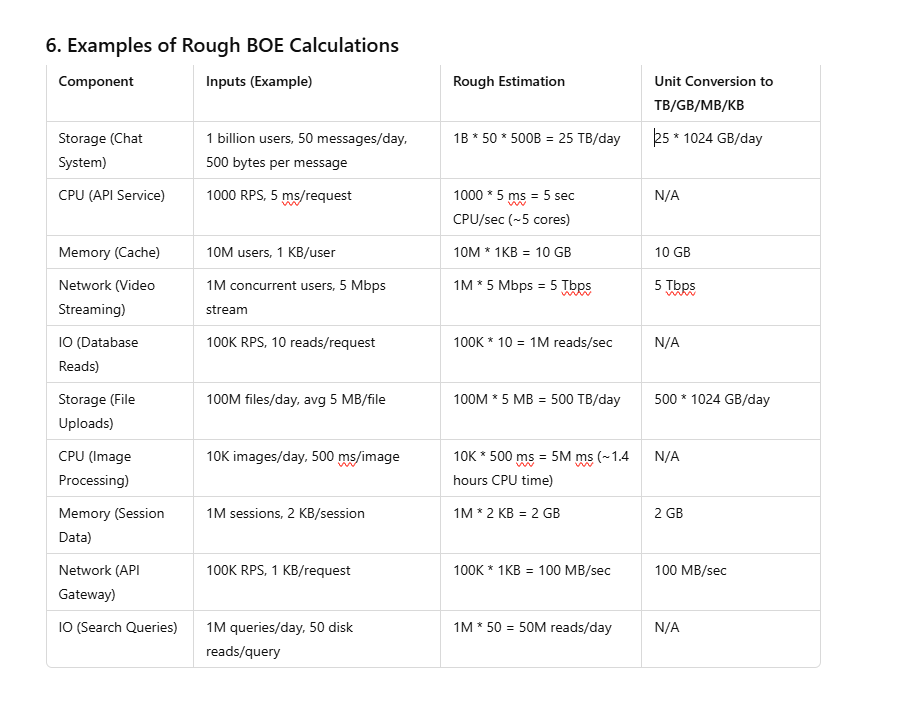Mastering Back-of-the-Envelope (BOE) Calculations in System Design Interviews
Demystifying Back-of-the-Envelope (BOE) Calculations – Overcoming Estimation Anxiety and Building Confidence in System Design Interviews
System design interviews are often considered the most challenging phase for candidates aiming for senior software engineering, architect, and managerial roles. Among the various skills tested, Back-of-the-Envelope (BOE) calculations frequently cause anxiety, even for experienced engineers. These rough estimations, done quickly without detailed calculations, are critical to demonstrating a candidate’s ability to reason about the scale and feasibility of a system. This article explores the nuances of BOE calculations and how to master them.
1. Why Do Engineers Fear BOE Calculations?
Even professionals with strong technical backgrounds find BOE calculations daunting. The fears often stem from:
Lack of Practice: Daily work in software development often doesn't require rough system estimates; this skill atrophies over time.
Which All BOE Needs to Be Calculated: Candidates often struggle to determine which types of BOE calculations are necessary for a given problem.
Pressure to Be Exact: Engineers are trained to be precise, making rough approximations feel uncomfortable.
Fear of Being Wrong: Estimations can feel like a high-stakes gamble during an interview.
Unit Confusion: Mixing up units like bytes, kilobytes, requests per second, or GB per month can lead to embarrassing mistakes.
Mental Math Hesitation: Candidates often worry about making calculation errors under pressure.
Recognizing these fears is the first step toward overcoming them.
2. Importance of BOE Calculations in System Design
BOE calculations are vital because they:
Validate Feasibility: Help assess whether the proposed system can scale to the required level.
Identify Bottlenecks: Estimate where performance issues might arise (e.g., bandwidth, storage, or CPU).
Guide Design Decisions: Enable trade-off discussions (e.g., caching vs. database reads, vertical vs. horizontal scaling).
Showcase Engineering Judgment: Demonstrate the candidate’s ability to reason through constraints and complexity.
3. Types of BOE Calculations
BOE calculations can be categorized into different types depending on the context:
Traffic Estimates: Requests per second (RPS), concurrent users, daily active users.
Storage Estimates: Data size per user, database growth over time, backup requirements.
Bandwidth Estimates: Data transfer per request, peak network throughput.
Memory Estimates: Cache size, in-memory session storage, index overhead.
Compute Estimates: CPU cycles per request, required number of servers.
Cost Estimates:Less Used Cloud costs, storage costs, data transfer fees
4. When to Use BOE Calculations (and When Not To)
Every system design problem doesn't require all types of calculations. Knowing what to estimate is key:
How to Identify Which BOE is Needed
Understand the Critical Path: Focus on the components that handle the heaviest load or are likely bottlenecks.
Align with Requirements: If the system is read-heavy, traffic and caching calculations might matter more than write throughput.
Consider the System Type: Video platforms require bandwidth and storage focus, while messaging systems demand traffic and storage calculations.
Ask Clarifying Questions: Probe for scale, user base, and data retention requirements.
5. How to Master BOE Calculations
Mastery over BOE calculations requires structured practice:
Familiarize with Ballpark Numbers: Know common values like:
1 GB = 1024 MB
1 request payload ~ 1 KB (typical API request)
1 server can handle ~1000 RPS (depends on the workload)
Text data storage ~ 1 KB per user message
Practice Mental Math: Break calculations into simple multiplications and divisions (e.g., 365 days ~ 400, 1024 ~ 1000).
Solve Real-world Problems: Practice rough estimations for systems you use daily (e.g., estimate WhatsApp message storage or YouTube daily data transfer).
Learn from Mistakes: Review your calculations post-interview or practice session; understand where you went wrong.
Templates & Checklists: Develop a mental checklist:
Traffic? Storage? Bandwidth? Memory? Compute? Cost?
7. Common BOE Calculation Pitfalls
Ignoring Growth: Always estimate with growth projections (e.g., 10x traffic increase in a few years).
Overcomplicating: Keep it simple; round numbers to simplify mental math.
Missing Assumptions: Clearly state assumptions (e.g., average video length = 5 minutes, image size = 200 KB).
Unit Inconsistency: Convert all units to a common base (e.g., bytes, seconds).
8. BOE Calculations as a Differentiator
Strong BOE estimation skills set candidates apart. They signal that you:
Understand system scale.
Can balance performance, cost, and complexity.
Possess practical engineering judgment beyond textbook knowledge.
Final Thoughts
BOE calculations are not about perfection; they are about demonstrating your understanding of scale and system constraints. They allow interviewers to see how you think and how you break down a problem under uncertainty. Practice regularly, build your intuition, and soon BOE calculations will become a natural and powerful tool in your system design toolkit.





